What's behind the Sharp Slide in Gold and Silver?
Commodities / Gold & Silver May 01, 2008 - 01:12 PM GMTBy: Gary_Dorsch

 After watching the price of silver soar to as high as $15 /ounce in May 2006, Warren Buffet, the “Oracle of Omaha” offered some sagely words of wisdom. “What the wise man does at the beginning, the fool does at the end. At the start of the party, the punch is flowing and everything's going well, but you know at midnight, it's all going to turn into pumpkins and mice. People think they'll be able to get out just before midnight, but everyone else thinks that too. The problem is that, in commodities there are no clocks on the wall,” Buffet warned.
After watching the price of silver soar to as high as $15 /ounce in May 2006, Warren Buffet, the “Oracle of Omaha” offered some sagely words of wisdom. “What the wise man does at the beginning, the fool does at the end. At the start of the party, the punch is flowing and everything's going well, but you know at midnight, it's all going to turn into pumpkins and mice. People think they'll be able to get out just before midnight, but everyone else thinks that too. The problem is that, in commodities there are no clocks on the wall,” Buffet warned.
Nine years earlier, in 1997, Buffett had begun accumulating 130-million ounces of silver, or nearly one-third of the entire world's supply, at roughly $4.50 per ounce for around $572 million. His public announcement of the silver purchases sent the price up to $7.50 an ounce from just under $6.00 in a few weeks. Then it was discovered that Mr. Buffett was taking delivery of March silver while selling July futures contracts. As quickly as silver prices soared, they plunged.
But by May 2006, silver was spiraling higher again, doubling to $15 /oz, and Buffet lamented before his shareholders that he had sold his silver too early, and did not profit much from the sale. Still, Buffet's warning of a commodity bubble that was ready to deflate, was initially proven correct, when silver tumbled 32% and gold fell 24% over the next five weeks. Other key commodities such as copper and crude oil fell by a third by year's end from their peak levels that year.
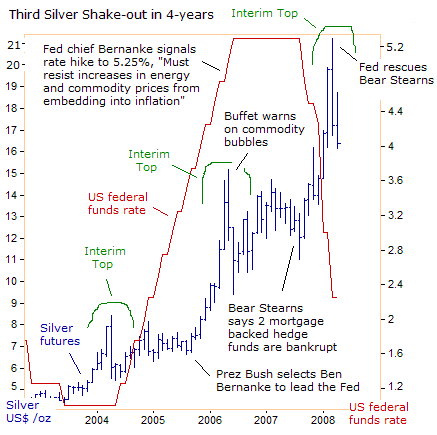
Yet in hindsight, the perceived “bursting” of the silver bubble in May-June 2006, from a peak of $15 /oz, to as low as $10 /oz, was simply a wicked correction within the context of a long-term bull market. Fourteen months later, silver would mount another spectacular rally, this time to as high as $21.25 /oz, and surpassing the May 2006 high by 40 percent. Now, for the third time in the past four years, silver is undergoing yet another wicked correction from a spike top.
The May-June 2006 slide in the silver market was triggered by a surprise rate hike by the Fed to 5.25%, above the perceived “neutral rate” of 5%, leaning on the side of restraint, to keep the powerful “Commodity Super Cycle” in check. Fed chief Ben “Helicopter” Bernanke was anxious to shed his dovish reputation after he had secretly confided to CNBC reporter Maria Bartiromo, “It's worrisome that people look at me as dovish and not as an aggressive inflation-fighter.”
Bernanke tried to reinvent himself as a hawk on June 1, 2006, when he told the International Monetary Conference in Washington, “The Fed will be vigilant to ensure that the recent pattern of elevated monthly core inflation readings is not sustained. The Fed must continue to resist any tendency for increases in energy and commodity prices to become permanently embedded in core inflation,” he warned.
Bernanke held the fed funds rate steady at 5.25% for more than a year, even as US home prices began their historic slide. Silver prices were locked in a sideways trading range, gyrating between $11 and $15 /ounce. But when startling revelations about the $1.8 trillion sub-prime mortgage crisis began to surface in the summer of 2007, threatening to topple Wall Street banks and brokers, Bernanke panicked and opened the money spigots, thus jettisoning the silver market to above $20 /oz.
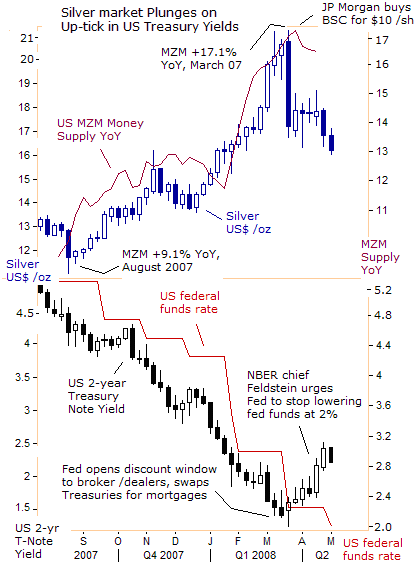
Silver peaked on March 17th, near $21.25 /oz, coinciding with the Fed's eleventh hour rescue of Bear Stearns from bankruptcy. Since then, silver has tumbled 25% to $16 /oz, enduring its third major shake-out in the past four-years. Whereas the 2006 shake-out in the silver market was triggered by the Fed's surprising 0.25% rate hike to 5.25%, the latest slide is based on opposite ideas - that the Fed's rate cutting spree has arrived at a dead-end at 2 percent.
In today's highly sophisticated financial marketplace, there is no longer any need to employ Federal Reserve officials to figure out the most appropriate target level for the federal funds rate. Instead, it's done by remote control, by traders in the US Treasury and Chicago interest-rate futures markets, who are usually several steps ahead of the political lackeys sitting at the Fed.
A pause in the Fed's rate cutting campaign was signaled when yields on the US Treasury's two-year note moved above the 2.25% fed funds rate last week. Treasury yields jumped after NBER chief economist Martin Feldstein, a close confidant of Mr Bernanke, said on CNBC television., “It would make sense for the Fed to stop cutting its target rate at between 2% and the current 2.25%, because to go lower could exacerbate the problem of inflation emanating from high commodity prices.”
On April 9th, former Fed chief Paul Volcker lashed out at the Bernanke Fed's super-easy monetary policy, which has fueled the biggest commodity bubble since the 1970's. “When concerns about recession are rife, the central bank will be tempted to subordinate the fundamental need to maintain a reliable currency, to the impulse to shore up a flagging economy. The danger is that you lose both battles, as the US did in the 1970's, and wind up with stagflation,” he warned. “The Fed has a particular duty to defend the integrity of the fiat currency in its charge,” Volcker added.

But the political lackeys at the Fed take their marching orders from the Bush White House, and US “Plunge Protection Team” commander Henry Paulson, who are calling the shots on monetary policy. “I've got confidence in the Fed and I've been very supportive of what the Fed has done and what the Fed is doing,” Paulson said after the central bank lowered its key interest rate 0.25% to 2.0 percent.
The latest shake-out in silver and gold may have a little further to go, but for investors betting on higher commodity prices in the longer-term, fueled by strong Asian demand, explosive money supply growth, and negative interest rates in the United States, one should recall the advice of the London trading wizard Nathan Rothschild, “The time to buy is when the blood is running in the streets.”
ECB Hawks Trip the Precious metals
Unlike the rookies at the Bernanke Fed, the hawks at the European Central Bank aren't bullied by politicians or German schatz traders in Frankfurt, who campaigned hard for a series of ECB rate cuts in the first quarter. German 2-year yields fell as low as 3.10% in February, or 90 basis points below the ECB's repo rate, anticipating rapid-fire rate cuts to re-inflate the battered European stock markets.
But fighting inflation is the top priority for the ECB, said Greek central banker Nicholas Garganas on Feb 6th. “Our monetary policy is not led on what the markets expect. I'm very concerned about the high inflation rate. Inflation risks remain on the upside,” he said. Consumer price inflation in the Euro zone hit a 16-year high of 3.6% in March. But when German schatz yields still refused to move higher, Bundesbank chief Axel Weber stepped in to set the markets straight.
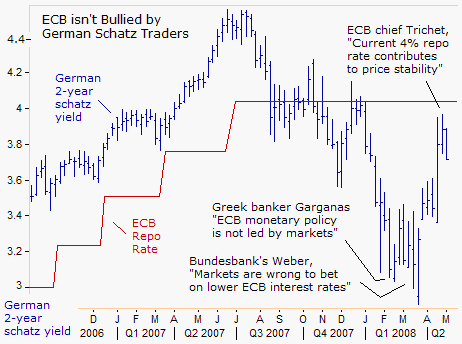
“Interest-rate expectations for the Euro region don't reflect the monetary-policy assessment of a central bank that's obliged to maintain price stability. Be assured, our aim is and remains price stability in the medium term,” he said on Feb 27th. Then on April 17th Weber said, “Recent wage dynamics in conjunction with elevated and persistent energy and food price pressures have increased the risk of a prolonged period of intolerably high inflation,” ruling out an easier monetary policy.
“Against this background, we will have to continuously monitor closely all incoming data and evaluate whether the current level of interest rates in fact ensures achieving our objective,” Weber warned. With the recovery of the European stock markets above their March 17th lows, German 2-year schatz yields eventually shot higher to within spitting distance of the ECB's 4% repo rate.
The ECB has kept its repo rate steady at 4% for eleven months, and throughout the US sub-prime mortgage crisis which began last summer, in sharp contrast to other members of the G-7 central bank cartel, such as the Bank of Canada, England, and the Fed, who capitulated to political pressure, and slashed their overnight lending rates, despite signs of explosive commodity inflation and money supply growth.
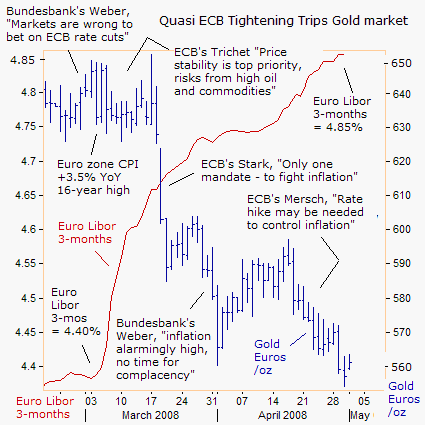
While the ECB has held its repo rate steady at 4% this year, Jean “Tricky” Trichet has pulled another fast one, allowing the 3-month Euro Libor rate to climb 45 basis points higher to 4.85%, thus engineering a clandestine tightening of monetary policy. Higher Euro Libor rates are indicative of instability in the European banking system, with its arteries clogged by toxic US mortgage debt.
But unlike the Fed and the Bank of England, the ECB hasn't taken any extraordinary measures to flood the banking system with excess liquidity, and counter the sharp rise the Euro Libor rates. Combined with open mouth operations to push German 2-year schatz yields higher, the ECB has managed to steer money away from the precious metals markets and into higher yielding European credit markets.
Japanese Bond Traders awaken from Grand Illusion,
Japanese bond traders have been brainwashed by government propaganda artists, and are taught that Japan, one of the world's biggest importers of food and energy, is immune to global inflation. But after reporting a decade of deflation, Ministry of Finance apparatchniks are finally forced to paint a rising inflation trend, after crude oil prices doubled and a ton of Asian grown rice soared 140% from a year ago.
Last week, Japanese consumer inflation was reported at a decade-high of 1.2% in March, led by rising fuel, raw materials and food prices. Ironically, the Bank of Japan's super-low interest rate of 0.50% encourages global traders to borrow funds in yen, in order to bid-up commodities and stocks worldwide. Yet it's tough to get the BoJ to shift to a tighter money policy, because the Japanese government is addicted to low interest rates, saddled with a national debt of $6.7 trillion.
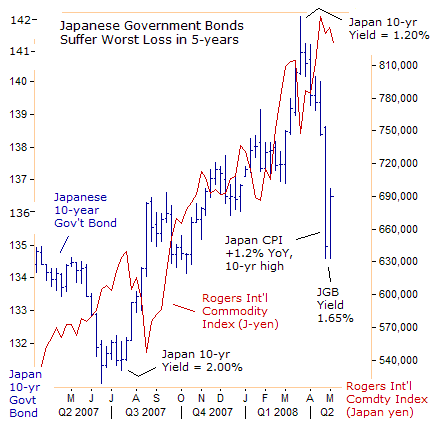
To avoid hiking interest rates to curb inflation, the Japanese ministry of finance allowed the yen to strengthen by 12% against the US dollar to hold down the cost of soaring commodity imports. “A stronger yen will ease the negative effect from rising costs of crude oil and commodities,” said former BoJ chief Toshihiko Fukui on March 7th. It was a historic shift in Tokyo's foreign exchange policy, which had intervened with a strong hand in prior years, to prevent the dollar from falling below 106-yen, the break-even point for many Japanese exporters and multinationals.
Yet despite the stronger yen, the Rodgers International Commodity Index, (RICI) the most diversified index, including 35-commodities traded on 11-global exchanges, is up 47% from a year ago, near a record 850,000-yen. Yet Tokyo traders were bidding-up Japanese bond prices alongside rising commodity prices for nearly eight-months, and knocking bond yields 80 basis points lower to 1.20 percent.
Since the two markets can't co-exist in a bull-market forever, and with the RICI refusing to budge from its record high, the Japanese government bond snapped first, and suffered a violent backlash, with its biggest one-week loss in 5-years. The lead JGB futures contract fell as much as 2-½ points last Friday, triggering the first-ever halt in trading. Schizophrenic JGB traders did a 180 degree flip, and switched their sights towards a Bank of Japan interest rate hike to 0.75 percent.
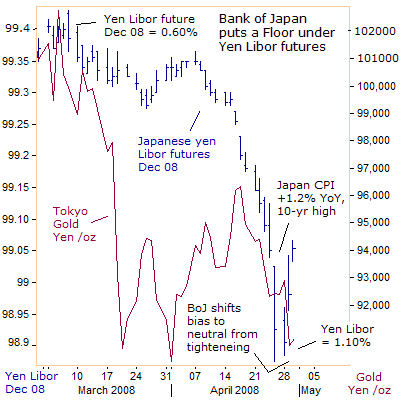
Yen Libor futures (Dec '08) suffered their worst losses in 16-years, tumbling 15-ticks to 98.90, and lifting its yield to 1.10%, or 60 basis points above the BoJ's overnight loan rate. Seeking to quickly extinguish expectations of a rate hike, the BoJ, under its new boss Masaaki Shirakawa, switched its tightening bias to neutral on April 30th. “The outlook for economic activity and prices is highly uncertain. It is not appropriate to predetermine the direction of future monetary policy,” the BoJ said.
“Given that the economy is underperforming compared with expectations and risks are rising, our stance can be described as flexible,” explained BoJ chief Shirakawa. However, any heavy-handed move by the BoJ to jig the Yen Libor and JGB market higher, would be of great interest to Tokyo gold traders, who have priced in a BoJ rate hike to 0.75%, by knocking the yellow metal 12% lower to 90,000-yen /oz.
By Gary Dorsch,
Editor, Global Money Trends newsletter
http://www.sirchartsalot.com
To stay on top of volatile markets, subscribe to the Global Money Trends newsletter today, for insightful analysis and predictions for the (1) top stock markets around the world, (2) Commodities such as crude oil, copper, gold, silver, and related gold mining and oil company indexes (3) Foreign currencies (4) Libor interest rates, global bond markets and central bank monetary policies, and (5) Central banker "Jawboning" and Intervention techniques that move markets.
GMT filters important news and information into (1) bullet-point, easy to understand analysis, (2) featuring "Inter-Market Technical Analysis" that visually displays the dynamic inter-relationships between foreign currencies, commodities, interest rates and the stock markets from a dozen key countries around the world. Also included are (3) charts of key economic statistics of foreign countries that move markets.
Subscribers can also listen to bi-weekly Audio Broadcasts, with the latest news on global markets, and view our updated model portfolio for Q'1, 2008. To order a subscription to Global Money Trends, click on the hyperlink below, http://www.sirchartsalot.com/newsletters.php
Mr Dorsch worked on the trading floor of the Chicago Mercantile Exchange for nine years as the chief Financial Futures Analyst for three clearing firms, Oppenheimer Rouse Futures Inc, GH Miller and Company, and a commodity fund at the LNS Financial Group.
As a transactional broker for Charles Schwab's Global Investment Services department, Mr Dorsch handled thousands of customer trades in 45 stock exchanges around the world, including Australia, Canada, Japan, Hong Kong, the Euro zone, London, Toronto, South Africa, Mexico, and New Zealand, and Canadian oil trusts, ADR's and Exchange Traded Funds.
He wrote a weekly newsletter from 2000 thru September 2005 called, "Foreign Currency Trends" for Charles Schwab's Global Investment department, featuring inter-market technical analysis, to understand the dynamic inter-relationships between the foreign exchange, global bond and stock markets, and key industrial commodities.
Copyright © 2005-2008 SirChartsAlot, Inc. All rights reserved.
Disclaimer: SirChartsAlot.com's analysis and insights are based upon data gathered by it from various sources believed to be reliable, complete and accurate. However, no guarantee is made by SirChartsAlot.com as to the reliability, completeness and accuracy of the data so analyzed. SirChartsAlot.com is in the business of gathering information, analyzing it and disseminating the analysis for informational and educational purposes only. SirChartsAlot.com attempts to analyze trends, not make recommendations. All statements and expressions are the opinion of SirChartsAlot.com and are not meant to be investment advice or solicitation or recommendation to establish market positions. Our opinions are subject to change without notice. SirChartsAlot.com strongly advises readers to conduct thorough research relevant to decisions and verify facts from various independent sources.
Gary Dorsch Archive |
© 2005-2022 http://www.MarketOracle.co.uk - The Market Oracle is a FREE Daily Financial Markets Analysis & Forecasting online publication.


